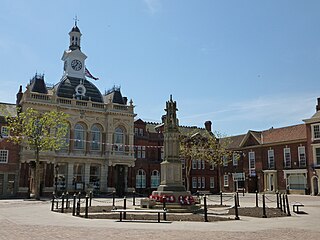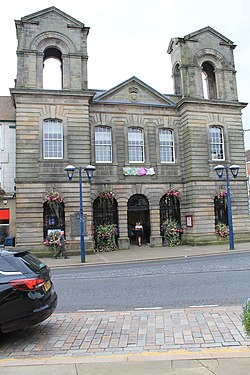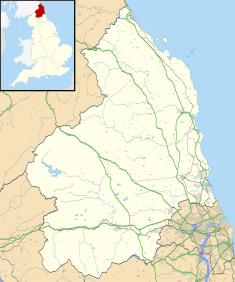
Congleton is a town and civil parish in the unitary authority of Cheshire East in Cheshire, England. The town is by the River Dane, 21 miles (34 km) south of Manchester and 13 miles (21 km) north of Stoke on Trent. At the 2011 Census, it had a population of 26,482.

Hexham is a market town and civil parish in Northumberland, England, on the south bank of the River Tyne, formed by the confluence of the North Tyne and the South Tyne at Warden nearby, and close to Hadrian's Wall. Hexham was the administrative centre for the Tynedale district from 1974 to 2009. In 2011, it had a population of 13,097.

Morpeth is a historic market town in Northumberland, North East England, lying on the River Wansbeck. Nearby towns include Ashington and Bedlington. In the 2011 census, the population of Morpeth was given as 14,017, up from 13,833 in the 2001 census. The earliest evidence of settlement is believed to be from the Neolithic period, and some Roman artifacts have also been found. The first written mention of the town is from 1080, when the de Merlay family was granted the barony of Morpeth. The meaning of the town's name is uncertain, but it may refer to its position on the road to Scotland and a murder which occurred on that road. The de Merlay family built two castles in the town in the late 11th century and the 13th century. The town was granted its coat of arms in 1552. By the mid-1700s it had become one of the main markets in England, having been granted a market charter in 1200, but the opening of the railways in the 1800s led the market to decline. The town's history is celebrated in the annual Northumbrian Gathering.

Castle Morpeth was a local government district and borough in Northumberland, England. Its administrative centre was the town of Morpeth.

Earl of Carlisle is a title that has been created three times in the Peerage of England.

George William Frederick Howard, 7th Earl of Carlisle,, styled Viscount Morpeth from 1825 to 1848, was a British statesman, orator, and writer.
Edward Howard, 2nd Earl of Carlisle, known as Viscount Morpeth from 1661 to 1685, was an English Whig politician.

The Old Town Hall was a former municipal facility at the corner of King Street and Rodney Street in Wigan, England. The building, which was demolished in September 2013, had been designated a Grade II listed building in 1990.

Poole Civic Centre is an Art Deco municipal building in Poole, Dorset. Since 7 October 2019 the building has been a Grade II listed building. Also sometimes known as Poole Town Hall, the civic centre was the headquarters of Poole Borough Council until 2019.

Brighouse Town Hall is a former municipal building in Thornton Square, Brighouse, West Yorkshire, England. The town hall, which was the headquarters of Brighouse Borough Council, is a Grade II listed building.

Ossett Town Hall is a municipal building in the Market Place, Ossett, West Yorkshire, England. The town hall, which was the headquarters of Ossett Borough Council until 1974, is a grade II listed building.

Dukinfield Town Hall is a municipal building in King Street, Dukinfield, Greater Manchester, England. The town hall, which was the headquarters of Dukinfield Borough Council, is a grade II listed building.

Retford Town Hall is a municipal building in The Square, Retford, Nottinghamshire, England. The town hall, which was the meeting place of Retford Borough Council, is a grade II listed building.

Deal Town Hall is a municipal building in the High Street in Deal, Kent, England. The town hall, which was the headquarters of Deal Borough Council, is a Grade II listed building.

Huntingdon Town Hall is a municipal structure on Market Hill in Huntingdon, Cambridgeshire, England. The town hall, which was the headquarters of Huntingdon Borough Council, is a Grade II* listed building.

Romsey Town Hall is a municipal building in the Market Place in Romsey, Hampshire, England. The structure is the meeting place of Romsey Town Council.

Ripon Town Hall is a municipal building in the Market Place, Ripon, North Yorkshire, England. The structure, which was the headquarters of Ripon Borough Council, is a Grade II* listed building.

Alnwick Town Hall is a municipal building in the Market Place, Alnwick, Northumberland, England. The structure, which was the meeting place of the common council, is a Grade I listed building.

Helston Guildhall, also known as Helston Town Hall, is a municipal building in Church Street, Helston, Cornwall, England. The structure, which is the meeting place of Helston Town Council, is a Grade II* listed building.

Glastonbury Town Hall is a municipal building in Magdalene Street, Glastonbury, Somerset, England. The structure, which is the meeting place of Glastonbury Town Council, is a Grade II* listed building.




















